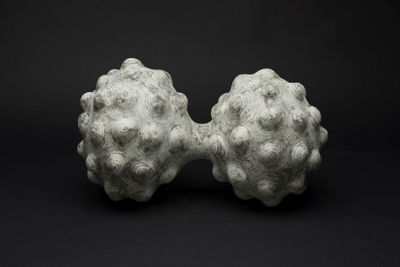Daphne Corregan
Daphne Corregan takes pleasure in distracting objects away from their original function by distorting and stretching them to impossible dimensions in order to magnify them and make them playful. Ceramist and sculptor, her forms originate on paper. It is these drawings which will determine the technique she will need to create them. Born in 1954 in Pittsburgh, PA, USA, Corregan now lives in the south of France. Her time is divided between her studio and her job teaching sculpture and ceramics at the Ecole d'Arts Plastiques in Monaco. Corregan came to France at a young age and began her studies in art at the Beaux Arts in Toulon, Marseilles, and finally in Aix-en-Provence in 1977. Her first contacts with clay took place during her American schooling but her initiation to raku came later while studying ceramics with Jean Biagini in Aix. Jim Romberg's and Paul Soldner's visits were a revelation. "Jim used his slips and glazes like a painter uses his paints," she recalled. The different stages of firing and postfiring reduction, the coordination of gestures and the complicity of the artist with fire fascinated her. Corregan prefers to use a white raku clay with a talc content because of the soft yet almost metallic patinas she obtains with a strong smoking after firing. She uses one glaze and one engobe, each made up of gerstley borate, kaolin and silica, colored with oxides or stains, following no precise formula, used as such or mixed together depending on the degree of glossiness she might be searching for. She spends a great deal of time painting each piece, following the outlines of her drawings previously incised into the clay when it is still wet. One might speak of it more as coloring rather than glazing. She takes into account the fact that these engravings or incisions will become a rich black after smoking the work and in that way be reinforced and accentuated. "What particularly interests me," says Corregan, "is the transformation the clay surfaces and richness of tones obtained by smoking. The clay takes on a grey or black color and becomes a background for a more pictorial work. Whether I decide to cover I my work with decoration, or simply engrave or fill in my drawings with solid colors, or perhaps superimpose brushstrokes of a different quality of glaze and color, the smoking of the piece following firing tends to bind these different surface treatments to the body of the piece itself and therefore may be considered more as the skin of the work rather than its clothing." Corregan works more on the representation of the object than on the object itself. She wants to demonstrate that a pot for example, by removing it from its daily context may be just as important as a sculpture or painting. She will flatten it, exaggerate its size or even highlight only one of its details. She uses diverse materials such as clay, metal, glass or bronze. She works in series and in what we might classify into three families: destructured pots; geometric volumes; and sculpture/objects, often anthropomorphic.
Sort by
Display per page
Title: Two Heads
Artist: Daphne Corregan
Corregan twists functionality and expectation to play with the viewers sense of perception, “Two Heads” provides the annex for disorientating and knotty emotive frequencies and symbolism, its pared down sculptural form effectively opening up the chance for differing interpretations — two silhouettes connected and paradoxically reversed. The chalky, charcoal-like material surface is created by a process of smoking the raku clay after firing — the talc content providing a rich and metallic tonality which heightens and augments the applied colour & glaze.



